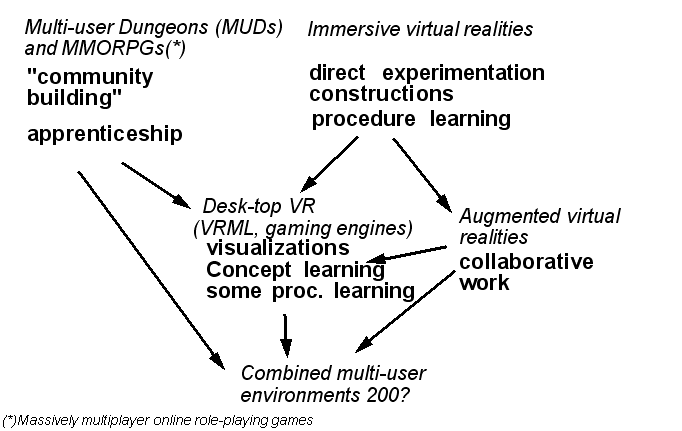Virtual environment: Difference between revisions
Jump to navigation
Jump to search
(using an external editor) |
(using an external editor) |
||
| Line 35: | Line 35: | ||
[[image:virtual_environments_typology.gif]] | [[image:virtual_environments_typology.gif]] | ||
== Links == | |||
* [http://www.mud.co.uk/dvw/bibliography.html Designing Virtual Worlds Bibliography] (excellent collection of online texts). | |||
== References == | == References == | ||
Revision as of 15:48, 29 March 2007
- Note: DSchneider is not happy with the organization of wiki entries dealing with virtual environment issues .... have to come up with clear terms and decide where to write
Definition
A virtual environment is a place with things that can be manipulated and people :).
Types of virtual environments (in random order):
- text-based virtual reality, such as MOOs and MUDs
- mixed reality environments
- Multi-user games with persistant storage features (mostly MMORPGs)
- Multi-user 3D interactive environments with persistant storage capabilities
- Immersive 3D environments, i.e. true immersive virtual reality environments
- any other form of virtual habitats
- Collaborative virtual environments (CVEs) - this includes habitats like MUDs, MMORPGs as well as some CSCW systems.
- Shared spaces
See also:
History
See Raph Koster's excellent Online World Timeline
Typology of virtual environments
There is no real consensus on what constitutes a virtual environment. See also Benford's categorization of shared spaces.
Here is a picture made by DSchneider that shows a variety of such environments and their potential for education:
Links
- Designing Virtual Worlds Bibliography (excellent collection of online texts).
References
- Dieberger, A. (1999) Social connotations of space in the Design for Virtual Communities and Social Navigation. In Munro, A., Höök K. & Benyon D. (Eds), Social Navigation of Information Space, pp. 35-54. Springer: London
